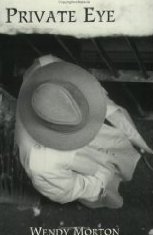
UNIVERSITY OF TORONTO LINKS
Wendy Morton : Review Of Private Eye
Beneath the Fedora: a review by Tanis MacDonald of :
Private Eye by Wendy Morton. Ekstasis Editions, 2001.
The cover of Private Eye shows a photo of a person of indeterminate gender wearing a fedora and a trench coat, languishing in an urban doorway: a real Sam Spade-Philip Marlowe image, iconic of a certain type of virile yet world-weary masculinity. This is the "private eye," also known, phallocentrically, as the private dick. The photo's subversive quality, its visual "confidence trick," becomes apparent as a second photo on the inside back cover reveals the private eye to be a woman, with Theda Bara hair and a wry smile beneath her fedora, the kind of woman who usually shows up at the detective�s office offering big complicated trouble. But the subversion goes further; beneath the dark wig is 60-year-old Wendy Morton, mother, insurance investigator, poet and host of the Mocambo Poetry Reading Series in Victoria. Just as her costume satirizes the image of the tough loner, Morton's poems undo the myth of the hard-boiled investigator. She brings to this collection, her first, the focus of her own "private eye," the act of looking as benediction, a wish for grace.

Many of the poems in this collection have a strong lyrical pull, and the best ones make sinuous connections between a single image and a complex pain, particularly in the elegies written for friends and family. Morton works extensively with images of the dance and the carnival, as the "private eye" gives way to the public display. Elegies are deceptively difficult to write; the universality of death must scrape up against the specificity of personal experience and memory. In Private Eye, the nightmare conflagration of "Circus, Burning" is a stand-out for its depiction of unbearable grief as "beautiful flames/ while the orchestra plays." "Bernie's Wake" and "Fred, I Need You" depict private moments that have been intentionally publicized, first through a grand, almost operatic gesture by the dying person, and then again by the poet, as gesture acknowledges gesture. More subdued and intimate are poems like "Wedding Picture," in which an old photo of the speaker's mother shows "a sensible bride�/ blooming in a small room." In "She Could Swim Like Esther Williams," Morton taps our grief for dead pets with a poem that resists both the maudlin and the ridiculous. The dog in this poem, with "her tail twirling/like a helicopter blade" stands in for all the other fading bodies of this book, the "lovely ghosts" to whom Morton dedicates Private Eye.
But this collection is not all about grief; the eroticism of "Motorcycle Wind" is particularly welcome from this older female poet, and reminds the reader of Dorothy Livesay's insistence upon the erotic in her later years. The pleasing formalism of the glosa form in "The Sandwomen" is also appreciated. Morton is adept at creating an intimate world from the stark reportage of newspaper items: the public turned private, turned public again through the poem. Another useful example of this "private eye" may be found in "Sleeping With Swans." While Morton explores a flock of lugubrious Yeatsian swans, a grocery list bleeds into the poem from the opposite side of the paper. The poem demonstrates the poignancy and humour of the domestic consciousness insinuating itself upon high art. This first collection by the sexagenarian Morton, her confident trick on gender expectations, debuts some intimate and evocative poetry.
Wendy Morton's works copyright © to the author.
